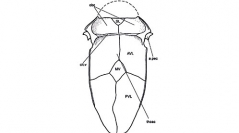

 Comptes Rendus Palevol
10 (5-6) - Pages 323-329
Comptes Rendus Palevol
10 (5-6) - Pages 323-329The presence of an aerial breathing organ in Placoderms is noticed in many textbooks on the history of breathing in Vertebrates. The origin of this interpretation is from a paper published in 1941 dealing with the interpretation of the differential sedimentary infilling of the armour of the antiarch Bothriolepis canadensis from the Late Devonian Escuminac formation of Canada. A revision of this material shows that if some sedimentary structures could be interpreted as traces of some digestive organs, none could be interpreted as putative lungs. The original proposal was based mainly on a presupposed mode of life of Bothriolepis in a freshwater environment of an alluvial plain. Recent studies of the Escuminac Formation environment conclude that it represents a marginal marine environment. Moreover, Bothriolepis has a worldwide distribution, notably in strictly marine environment. Thus, the presence of lungs in Bothriolepis remains highly questionable: it cannot be supported by anatomical, phylogenetic, nor biological arguments.
Bothriolepis , Taphonomy, Paleoanatomy, Lungs, Placodermi, Devonian